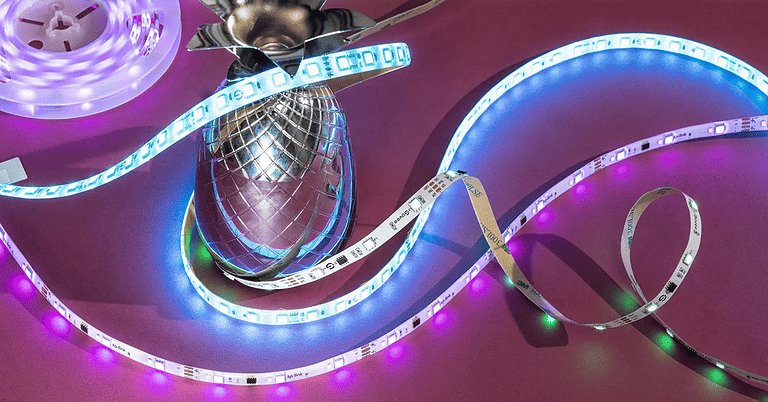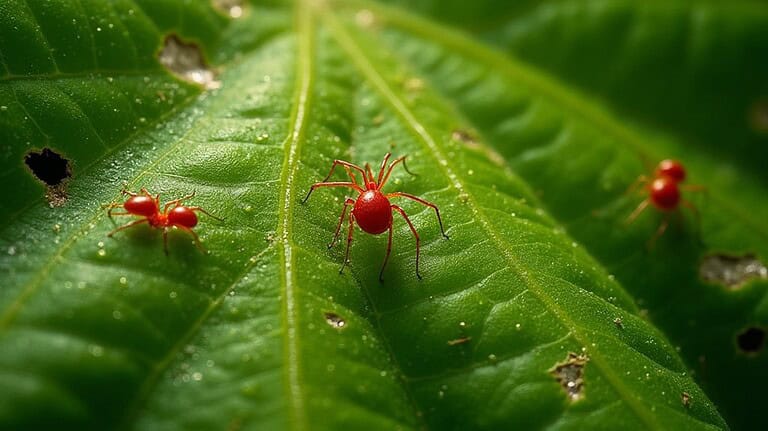Indoor Food Garden Ideas for Every Space
You can create a thriving indoor food garden in any space with the right setup! Start by choosing containers with good drainage and quality potting soil, then add LED grow lights to provide 6+ hours of daily light. Quick-growing options like lettuce, herbs, and microgreens are perfect for beginners, while vertical gardens and hydroponics help maximize limited space. Group plants with similar water needs, guarantee proper air circulation with fans, and you’ll be amazed at how much food you can grow indoors – there’s so much more to investigate in the world of indoor gardening.
TLDR
- Start with microgreens in shallow containers for quick harvests within 7-14 days, perfect for windowsills and countertops.
- Maximize vertical space using tiered planters and hanging baskets to grow herbs, dwarf tomatoes, and snackable peppers.
- Install LED grow lights with specific wavelengths to create optimal growing conditions in areas with limited natural light.
- Utilize kitchen scraps to regrow vegetables like green onions, celery, and lettuce for a sustainable indoor garden.
- Group plants with similar water needs in well-draining containers and maintain temperatures between 60-75°F for optimal growth.
Essential Indoor Garden Lighting Solutions
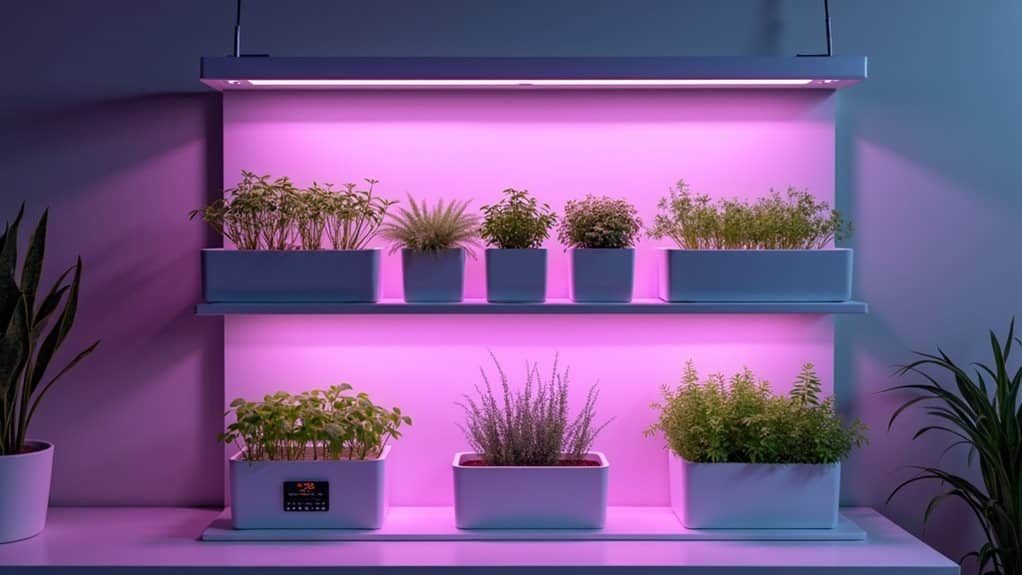
While growing plants indoors might seem challenging at first, choosing the right lighting solution is your key to success, and today’s technology makes it easier than ever to create the perfect environment for your indoor garden.
You’ll want to evaluate LED grow lights, which are incredibly energy-efficient and run cool, or smart grow lights that you can control right from your phone while adjusting the range for ideal plant growth. Modern LED grow lights can provide plants with specific light wavelengths that enhance their growth and overall yields. Additionally, ensuring proper airflow management is crucial for maintaining optimal conditions in your indoor garden, as it can significantly affect plant health and growth rates.
Selecting the Perfect Container Garden Setup
When you’re ready to create your indoor food garden, you’ll need to start by selecting containers that match your plants’ needs, whether you’re growing shallow-rooted herbs or deep-rooted tomatoes. Understanding the essential nutrients required for plant growth helps you choose the right soil and fertilizer for your indoor garden.
You can maximize your growing space by trying different methods like vertical gardening, tiered planters, or even hanging baskets, which let you fit more plants into tight spaces. Make sure to choose pots that have proper drainage holes to ensure healthy plant growth and prevent root rot.
For the best results, consider using a combination of container sizes and arrangements, such as placing larger pots on rolling casters for mobility, stacking smaller containers on shelves, and grouping plants with similar water needs together to make maintenance easier and more efficient.
Choose Right Container Size
Selecting the right container size stands as one of the most essential decisions you’ll make for your indoor food garden, and it’s not as complicated as you might think!
For herbs and leafy greens, you’ll do great with 14-inch pots, while your tomatoes and peppers need bigger homes – about 18 inches for determinate varieties and 24 inches for those sprawling indeterminate types.
Multiple Container Growing Methods
Three fantastic approaches to container gardening will revolutionize your indoor food-growing adventure!
You’ll love combining multiple self-watering plastic containers for herbs, creating a stunning triangle arrangement of vegetables in ceramic pots, or setting up a checkerboard pattern of wooden boxes.
Just remember to match your containers with similar-need plants, guarantee proper drainage holes, and maintain adequate spacing between your leafy friends.
Stack and Space Solutions
Whether you’re working with a tiny apartment or a spacious sunroom, excelling in the art of stacking and spacing your container garden can alter any indoor space into a thriving food oasis!
You’ll love how tiered plant stands and stair-step displays can modify vertical space, while modular stacking containers let you build upward efficiently.
Try combining compact varieties on wheeled caddies, so you can chase the sunlight throughout the day!
Space-Saving Vertical Garden Systems
You’ll be amazed at how much growing space you can create by taking advantage of your empty walls and corners with smart vertical gardening solutions.
Whether you’re looking at installing a sleek wall-mounted system with built-in irrigation or setting up a series of staggered corner shelves, vertical gardens let you pack tons of growing potential into previously unused spaces. Incorporating coffee grounds into your vertical garden can enhance soil health and provide essential nutrients for your plants.
Wall-Mounted Growing Solutions
When space feels tight in your home but you’re dreaming of growing your own fresh herbs and vegetables, wall-mounted growing solutions offer an incredibly clever way to convert ordinary walls into thriving gardens.
You’ll find plenty of options, from hanging pocket planters to adjustable grid systems, and you can even use recycled pallets to create your own custom setup with built-in irrigation that’ll keep your plants happy and healthy.
Maximizing Corner Shelf Space
Three ingenious corner shelf solutions can change those awkward, often-neglected spaces into thriving indoor food gardens that’ll make your green thumb proud.
You’ll love how multi-tiered plant stands maximize vertical space while keeping your herbs within easy reach, while hanging planters create a stunning cascade of edibles from above.
For the ultimate space-saver, try installing corner shelves with built-in self-watering planters.
Best Vegetables for Indoor Growing Success

Several popular vegetables can thrive magnificently in your indoor garden, making it easier than you might think to grow fresh produce right in your home!
You’ll love how quickly lettuce, radishes, and microgreens can go from seed to harvest, often in just 14-45 days.
For container-friendly options, try growing dwarf tomatoes or snackable peppers, while herbs like basil and mint will add fantastic flavor to your indoor garden.
Year-Round Indoor Fruit Growing Guide
Growing your own fruit indoors might sound like a challenging effort, but with the right knowledge and setup, you’ll be amazed at how rewarding it can be!
Start with easy-to-grow options like dwarf citrus trees or strawberries, which love bright windowsills and don’t need much space.
Remember to provide plenty of sunlight or LED grow lights, maintain proper humidity with a small humidifier, and don’t forget to hand-pollinate those blossoms!
Maximizing Small Spaces With Microgreens

If you’re ready to start your microgreens expedition, you’ll love how these nutrient-packed plants can change even the tiniest spaces into productive growing areas.
With just a few shallow containers, some quality organic soil, and your choice of seeds, you can create an efficient indoor garden that fits perfectly on your windowsill or countertop.
Starting with easy-to-grow varieties like lettuce and mustard greens, you’ll be amazed at how quickly you can harvest these tender shoots, which only take about 7-14 days from seed to plate.
This makes them perfect for impatient gardeners like yourself who want quick results.
Beginner Microgreen Growing Guide
Microgreens pack a powerful nutritional punch while being one of the easiest, most space-efficient crops you’ll ever grow indoors!
You’ll need just a few basic supplies: a shallow container with drainage, some growing medium like coconut coir, your choice of seeds, and a sunny windowsill.
Simply spread your seeds evenly, keep them moist, and within 7-10 days, you’ll be harvesting these nutrient-rich greens!
Space-Saving Container Techniques
Now that you’ve got the basics of microgreen growing down, let’s examine some clever ways to maximize your indoor growing space!
You’ll love how versatile containers can stack vertically, making use of your walls and corners.
Try repurposing old shelves or installing tiered systems, and don’t forget to investigate hydroponic options, which can reduce your space needs by an astonishing 99%.
Vertical planters are your best friend!
Creating Optimal Growing Conditions
While creating a thriving indoor garden might seem challenging at first, establishing the right growing conditions is actually quite straightforward when you understand the key elements at play.
You’ll want to keep your indoor temperatures between 60°F and 75°F, guarantee your plants get at least 6 hours of light daily, maintain good air circulation with fans, and don’t forget to use well-draining containers with quality potting soil.
Kitchen Counter Herb Garden Design
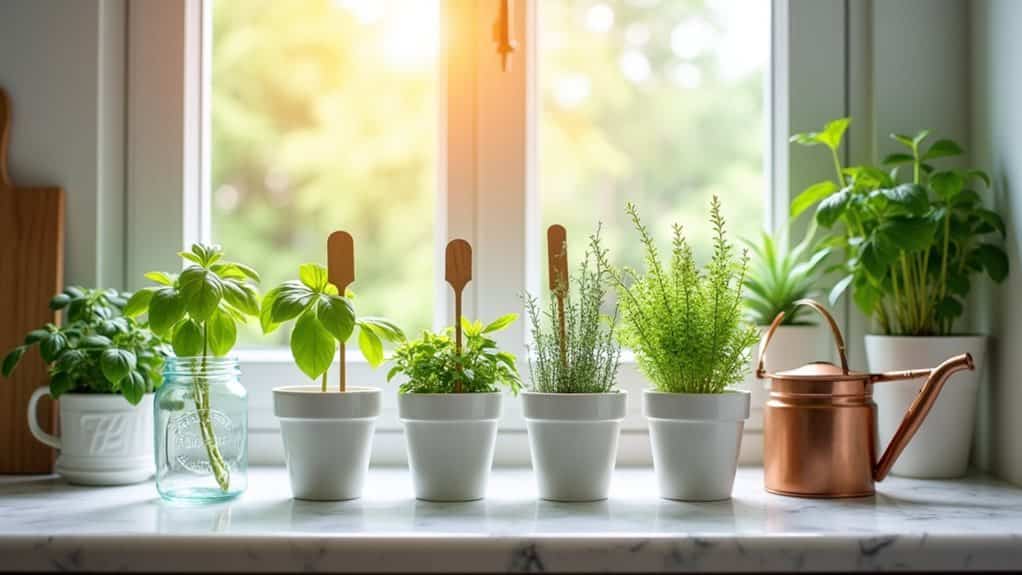
Setting up a beautiful herb garden in your kitchen doesn’t have to be complicated or expensive, especially when you’ve got so many creative container options at your fingertips!
You can convert everyday items like mason jars, vintage wine boxes, or even colorful ceramic planters into the perfect herb-growing spots.
For a space-saving solution, try mounting magnetic planters on your fridge or creating a vertical garden using a hanging file organizer.
Re-Growing Food From Kitchen Scraps
Converting your kitchen scraps into a flourishing indoor garden isn’t just a money-saving hack – it’s like having your own little science experiment right on your windowsill!
You’ll be amazed how easily you can regrow vegetables like green onions, celery, and lettuce from their leftover parts.
Just pop those root ends in water, place them in a sunny spot, and watch as nature works its magic.
Keep organic scraps whenever possible for the best results!
Advanced Indoor Growing Techniques
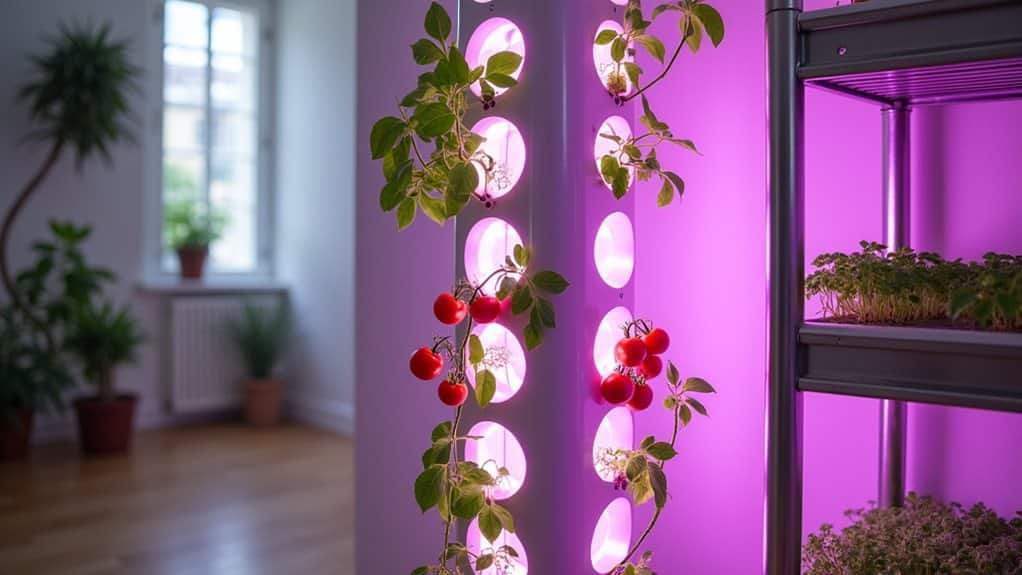
Now that you’ve perfected the basics of regrowing kitchen scraps, let’s investigate some seriously cool ways to take your indoor garden to the next level!
You’ll love exploring hydroponic systems, where plants grow in water instead of soil, and aeroponic setups that spray roots with nutrient-rich mist.
Want to get really fancy? Try vertical gardening with automated systems that’ll make you feel like a high-tech farmer!
Overall
Now that you’ve investigated these indoor gardening methods, you’ll find it’s easier than ever to grow fresh food right in your home, no matter how much (or little) space you’ve got! Whether you’re nurturing herbs on your windowsill, crafting a vertical lettuce garden, or experimenting with hydroponic systems, you’re well-equipped to create your own indoor food oasis. Remember, every gardening adventure starts with a single seed, so why not plant yours today?


